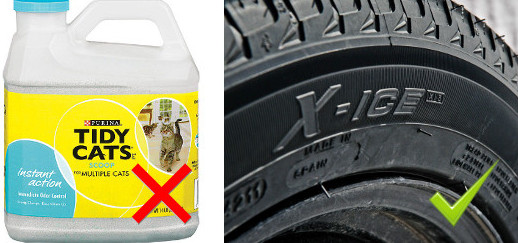Posts and Projects:

I’ve found that when it comes to winter tires, most people I know fall into two categories:
Those who’ve never run winter tires, and figure one round black rubber donut can’t be too different from another or that AWD/4WD compensates for bad tires…
and those who try out winter tires and never go back to all seasons.

For your cat, not your car.
You can find the first group driving excessively slow, sliding backward on inclines, holding up traffic and getting stuck in ditches. Here in Pennsylvania, we’re far enough north to have serious winter weather events, yet the majority don’t prepare their vehicles (or refrigerators) for it.
If you’re one of these people, I’m talking to you.
Yes, you might “get by” with all seasons. You can drive at a crawl, avoid steep hills and hope you make it home. You may even have AWD or 4WD, unfortunately, 4WD does nothing to assist in two very important collision avoidance maneuvers: stopping and turning.
A case for winter tires
1. A front wheel drive vehicle with winter tires is safer to drive in snow and ice than an AWD vehicle with all seasons. It can stop better, turn better and track in a straight line better. If you’re considering a Subaru to replace your 2WD vehicle and haven’t tried winter tires, try the tires first and possibly save yourself $25K+.
2. In the long run, winter tires are free. Assuming you plan to keep your car for the next 60K miles or so, winter tires and wheels will keep miles and road salts off of your summer set so they’ll last longer. Buy a cheap set of used wheels from eBay or Craigslist to mount your winter tires on. As the seasons change, bolt on the right set of wheels. Having a set of wheels off your car for half the year also gives you plenty of time to clean, inspect or paint them.
3. A single insurance claim will cost you more than the upfront cost of winter tires.
4. There are things insurance cannot fix.
5. Electronic systems like TCS/VCD/ABS cannot produce more traction than your tires provide and cannot compensate for inappropriate tires.
6. “Knowing how to drive” is not a substitute for winter tires. Skill doesn’t produce traction. The best drivers equip their cars appropriately for road conditions.
7. Running winter tires in the winter allows you to use specialized, high-performance summer tires and wheels, instead of compromising on an all-season tire and wheel package.
The difference
Compound – Winter tires are made from a softer rubber compound that stays pliable in low temperatures. Even on dry pavement winter tires outperform all-seasons.
Siping – Many winter tire designs have slits cut across the tread blocks which allow water to escape, improving grip.
Tread – The tread pattern is designed specifically for snow and ice. Typically, this means the tire has a higher void area to help channel snow away from the contact patch.
The M+S rating – This standard was developed by RMA of the US and RAC of Canada. It means the tire has met a certain standard of performance in the snow, has at least 25% void area and complies with other geometric requirements. In some Northern jurisdictions, drivers are required to install tires bearing this symbol during the winter.
On wheels
Find a set of winter wheels. If you’re on a budget, check Craigslist. Base model Imprezas come with 15″ wheels. These often end up for sale when their owners upgrade to alloys. I’ve had good luck with 15″ alloys from a Legacy.
15″ wheels are probably the best choice for snow and ice performance. Tires that fit 15″ wheels are often cheaper than those made for larger wheels. In addition, the larger sidewall provides greater road noise reduction, resistance to potholes and less opportunity for snow accumulation which can upset wheel balance.You could also shop for summer wheels and mount winter tires on your current set.
On tires
Blizzaks appear to be the best performers in snow and ice, at least early in their service life. They’re made from a soft compound which wears quickly and they’ve earned a reputation for fast wear. The tread compound begins as a soft outer layer and turns into a harder one, closer to that of an all-season tire. For this reason, I’ve avoided Blizzaks.
A close runner-up in terms of performance is the Michelin X-Ice series. My current set of X-Ice2 tires have spent a winter on my other car, four winters on the Impreza and still have 6/32″ of tread left. I will probably use them for another winter, then retire them. The latest iteration of the series is the X-Ice3, which is available at most tire shops including Costco.
Dunlop, Nokian, Firestone and others offer winter tires as well, though Bridgestone and Michelin appear to be the most popular.

All trademarks cited here are the property of their respective owners
